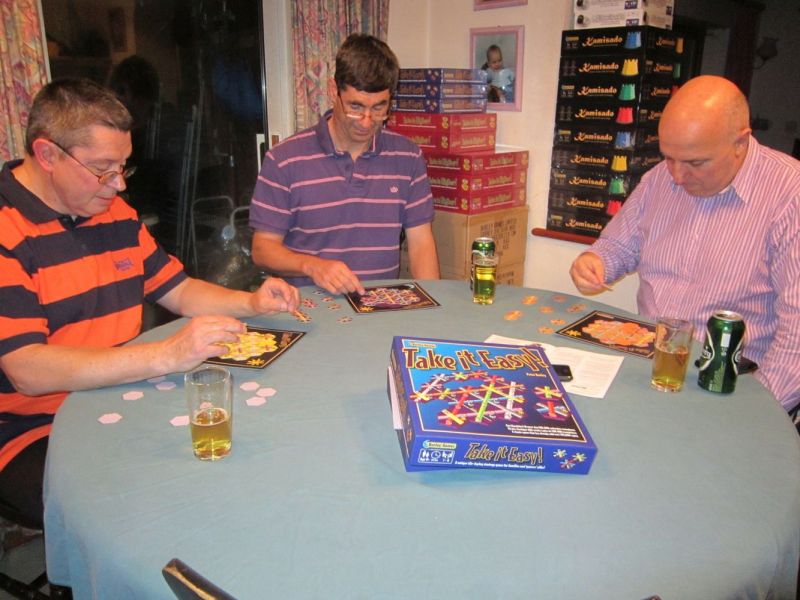
Games inventor Peter Burley has released one of his creations, Take It Easy, as an app. It can be downloaded from itunes for the princely sum of 69p.
Peter Burley is no stranger to this site; last August he told us about his game Kamisado. Here he tells us about Take It Easy, which he invented as long ago as 1983, but has just been released in a new format.

Games inventor Peter Burley has released one of his creations, Take It Easy, as an app. It can be downloaded from itunes for the princely sum of 69p.
Alexander Baron: Take It Easy is a puzzle/maze game. I’ve read the blurb on your site but can you talk us through it?
Peter Burley: Take It Easy is a tile laying strategy game. Hexagonal tiles are laid by players on their own personal hexagonal grids (or boards). The idea of the game is to outscore your opponents by building continuous lines of colour all the way across your board in each of the three available directions. For every such line, you will score the ‘base value’ of the colour of the line, multiplied by the length of the line (where the length is measured by how many tiles are in the line). There are nine different colours for the stripes on the tiles that join together to form lines when the tiles are placed. The ‘base values’ for the colours run from 1 (for grey) up to 9 (for yellow). So, for example, if you complete an unbroken orange line (base value 8) which is four tiles long and stretches from one side of your board to the other you will score 8 x 4 = 32 points.
AB: The original?
PB: The board game version: each player is given a set of 27 hexagonal tiles. Each tile has three stripes on it, one vertical stripe, one diagonal stripe from bottom left to top right and one diagonal stripe from top left to bottom right. Three colours run in each direction (i.e. there are three different colours for the vertical stripes, and three for each of the diagonal direction stripes). All permutations of the colours are represented once and only once, so there are 3 x 3 x 3 = 27 tiles in the set. On each stripe on a tile, there is a number representing the base value for that stripe colour.
Each player is provided with the same set of 27 tiles, but each player’s set will have a different background colour. Each player will also receive a board containing a hexagonal grid (as shown in the photographs) in the colour that matches that player’s tiles. There are 19 hexagonal spaces within the grid shown on the boards.
One player is nominated as ‘caller’. All players apart from the caller lay out their tiles face up, grouped together according to the vertical stripe colour (to make it easier to select a particular tile). The caller places all his/her tiles face down and then mixes them up. Then the caller selects tiles, at random, one at a time and reads out the colours/numbers on each tile selected. For each tile selected by the caller, all the other players will then select from their face-up stock the tile with the same stripe combination.
[Etc! Read more about it here.]
AB: I gather this game has been around for awhile and has won a certain amount of recognition.
PB: Take it Easy has won a number of prestigious awards, notably a nomination for Spiel des Jahres (Game of the Year) in Germany in 1994.
AB: The new version?
PB: The iOS Version of Take It Easy can be played on any iOS device (i.e. iPhone, iPod Touch or iPad). There are three separate playing modes, Classic, Puzzle and Progressive.
The developers have designed the Classic Mode to mirror the Take It Easy board game. The enhancements included within the Puzzle and Progressive Modes are excellent ideas and have added a whole new dimension to Take It Easy.
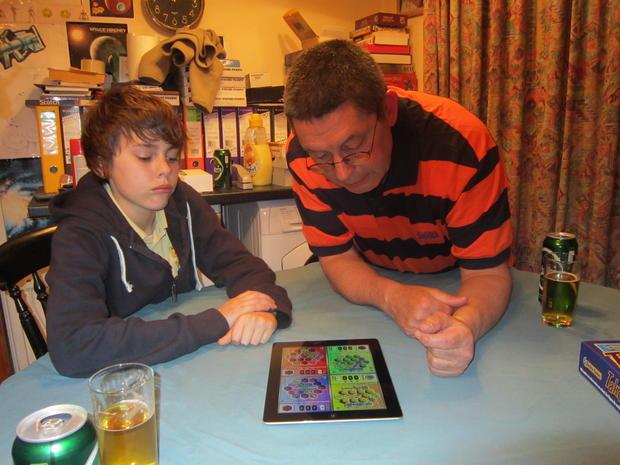
Take It Easy is a game for all age groups. Here, inventor Peter Burley demonstrates the ipad version for 4 players.
AB: When did you come up with it? Hopefully it had a more edifying inspiration than Kamisado?
PB: I came up with the idea in the early 1970s. It’s so long ago that I’m a little hazy as regards exactly what inspired the idea. I suspect it may have been a result of a visit with my parents to another family (who were also very much into board games) and playing a game involving the placing of standard playing cards in a 5 x 5 grid and simultaneously building poker hands in the horizontal and vertical directions. I saw the possibility of replacing the 5 x 5 grid by a honeycomb grid of hexagons, giving a third direction to build in, and at the same time removing the playing card element.
My first attempt at this involved having four colours in each direction. There were two problems with this. Firstly, that meant that each player would need 4 x 4 x 4 = 64 tiles. This was far too many to be manageable (particularly as at that time I was making the tiles by hand, using Daler Board, acrylic paints and Letraset numbers). So I tried a subset of 32 tiles, missing out half the tiles in a mathematically logical way. However, it was quite difficult to get many ‘scoring lines’ with four colours in each direction and so I switched to using just three colours in each direction and then things started to work a lot better!
AB: How many have you shipped to date?
PB: So far there have been a few thousand downloads. This has been without any launch, or marketing, or publicity of any kind. The first release at the end of January did not include any Multiplayer modes. The ‘Local Multiplayer’ version followed in March. This makes it possible for players to play against one another with a split screen on a single iOS device. Two player games are supported on iPhone and iPod Touch, while up to four players can play on a single, split iPad screen. During the first week in April, the full ‘Online Multiplayer’ option was added. This allows you to compete with other players anywhere in the world, where each player is using a separate device. We decided early on that we would hold the marketing effort back until both the Multiplayer versions had been released, as these options are very important to a lot of players. So the launch is now under way, and we will await with interest the increased sales figures as the marketing activities unfold.
AB: Why did you decide to put it out as an app?
PB: A number of years after the board game was first published, comments started to appear in various publications, both paper format and electronic, to the effect that Take It Easy had the potential to be much more than just a board game. One gentleman even suggested that it should replace Bingo as a national institution! Clearly, one way of taking it forward is via electronic formats. This started some while ago, and there are several implementations (or varying qualities) available via the Internet. Zabu Studio have themselves recently released a very nice version for Facebook, easily the best electronic version so far.
However, it had become clear to me over the last few years that the most exciting way forward would be to develop it as an iOS app. The obvious advantages when selling an app are that you can immediately take out of the equation the overheads for manufacture, shipping and warehousing that are associated with a board game. So this makes it possible to provide the product to the end-user at a very affordable price.
The final (and probably most important) reason is that it’s great to provide customers with a game they can carry around anywhere in their pockets and just start playing anytime, whether they are on a train or plane journey, or just waiting in a queue. It’s the immediacy that is so enticing, together with the opportunity for visually stunning graphics, fun special effects, and (last, but definitely not least) being able to just play and have the scoring all calculated for you as the game progresses.
Several companies had approached me during the last two years, asking if they could sign an agreement with me to allow them to develop Take It Easy as an iOS app. The approach from Zabu Studio came to me via a mutual friend. I did consider all my options for quite a while, but eventually decided to go with Zabu, as they seemed to be the most professional and knowledgeable outfit I had spoken to. I now feel that my decision was 100% the right one, as they have done a brilliant job in creating the Take It Easy app and have shown a wealth of imagination and creativity in adding the Puzzle and Progressive modes onto the existing game.
Zabu Studio was formed back in the summer of 2010. The team’s background is from EA’s Pogo studio, a pioneer in casual gaming on the Internet. The Zabu team has extensive experience in Video Games, and many years of experience in the Silicon Valley technology scene.
AB: Did you program the app yourself or is that something too technical even for a Mathematics graduate with an IT background?
PB: No chance! I wouldn’t have a clue as to where to start! My experience as a developer was many years ago, using languages such as Fortran, Cobol and Pascal. About twenty-five years ago, my IT career moved into different areas such as Project Management, Software Quality Assurance and (mainly these days) Technical Authoring. I did have a brief foray back into the development world about ten years ago, when I did a year or two programming in C, after having attended some courses for Web Development, C++ and Java. However, I didn’t find it as easy to pick up as I had done earlier in my career, and I should probably have taken heed of the well-known expression “You can’t teach an old dog new tricks”.
As for programming this kind of app, I can only stand back in amazement when I see what these guys can do, and all the things that are possible on these tiny, slimline devices. It’s way beyond my level of knowledge, and I’ll just leave it to the younger guys, who know exactly what they’re doing!
AB: How many do you expect to ship?
PB: The answer is that we really don’t know at the moment. Clearly we would hope that we can ship millions. It would seem that the very best of apps have achieved tens of millions of downloads, or possibly hundreds of millions. I’m not suggesting that Take It Easy will achieve sales figures of this order of magnitude, but at the same time it does seem to possess all the credentials required for a ‘top’ game.
AB: What profit do you expect to make on it, per unit and/or in total?
PB: The current version costs US $0.99, or €0.79 or £0.69 per download. Clearly the total revenue we can expect to take will depend on the number of downloads that are achieved and we have no way of knowing what the numbers will be just yet. Apple will automatically take 30% of the revenue stream and the rest will be shared out between myself and Zabu Studio.
AB: Are you developing any other games at present?
PB: I am working on a several things at the moment. One is a game called Zambezi which involves racing tugboats from Victoria Falls to Lake Kariba, avoiding crocodiles and rocks along the way, and also picking up commodities from staging posts and making ‘documentaries’ about the animals of the Zambezi delta. Two major publishers have expressed an interest in it.
I have also been working on a game called Space Hockey, where each player controls eight ‘flying saucers’ and tries to score goals by guiding the ‘rocket-ball’ through the opponent’s triangular goal (the goals each have three ‘posts’ and are hanging in space – you can score through any pair of posts from any direction).
A third game I have been working on goes by the working title of Alchemists Of Venice and involves the placement of octagonal tiles to gradually build the City of Venice, while at the same time creating a network of bridges throughout the city and collecting the elements (such as Vermillion, Brimstone and Vitriol), once thought to be vital ingredients in the process of alchemy. These elements are also used as ‘currency’ to permit your Tax Collector to cross other players’ bridges and to employ the services of the local gondoliers. The first player to find and/or create a certain number of units of gold (where this number varies depending on the number of players involved) is the winner.
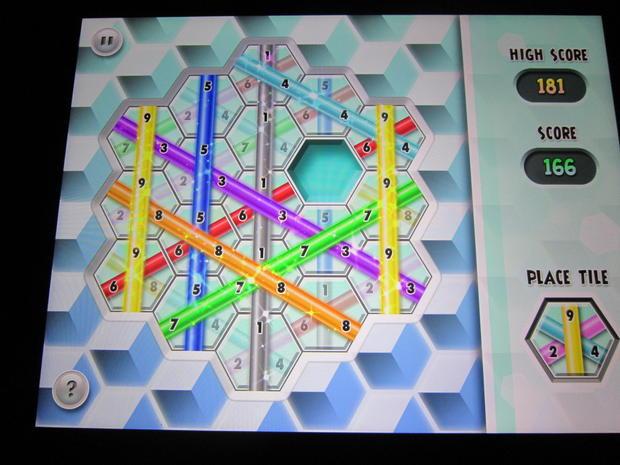
Take It Easy – the ipad version for one player.
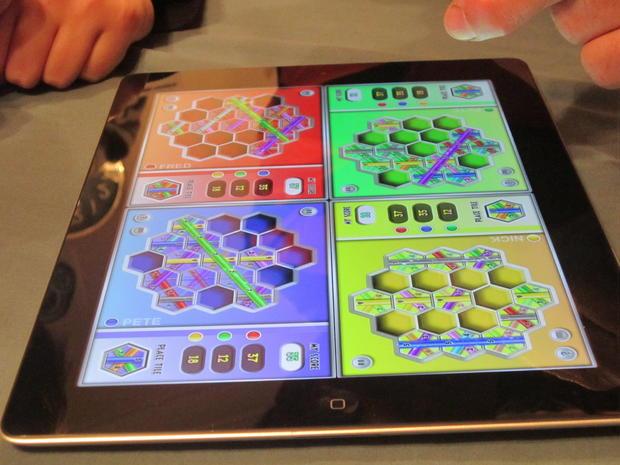
Take It Easy – the ipad version for 4 players.
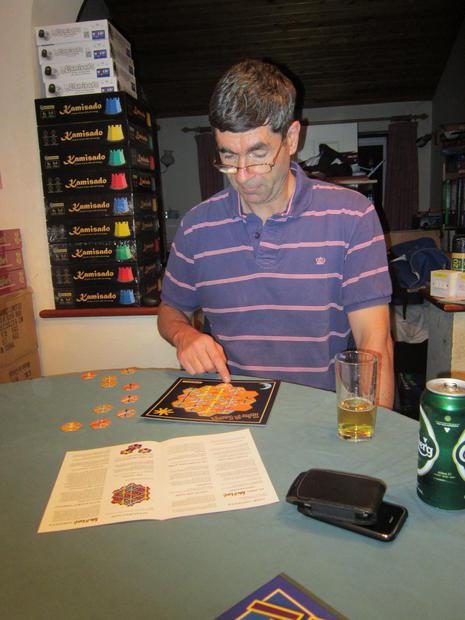
Take It Easy – especially when you adjust a tile!
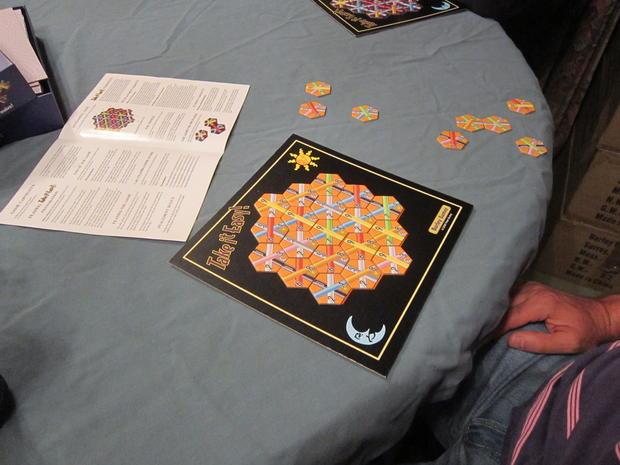
Take It Easy – a completed board.
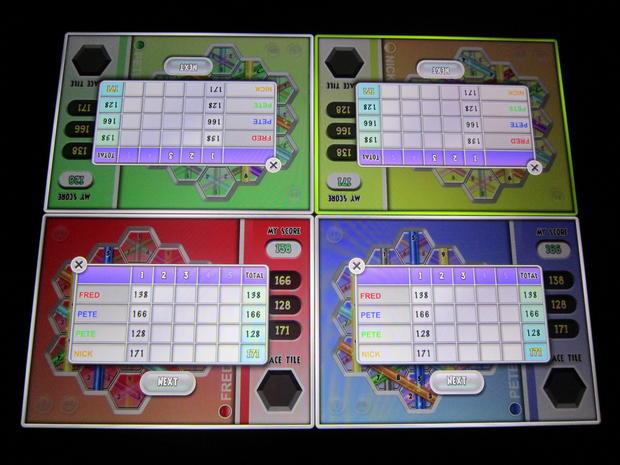
Take It Easy – another photograph of the ipad version for 4 players.
[The above article/review/interview was first published April 28, 2012. Take It Easy is italicised throughout. I believe Peter Burley was known as Pete Burley.]
Back To Digital Journal Index